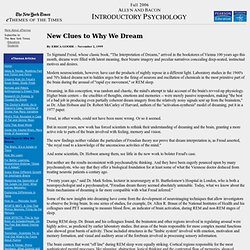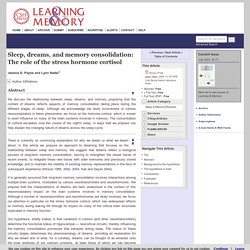

New Clues to Why We Dream. By ERICA GOODE – November 2, 1999 To Sigmund Freud, whose classic book, ''The Interpretation of Dreams,'' arrived in the bookstores of Vienna 100 years ago this month, dreams were filled with latent meaning, their bizarre imagery and peculiar narratives concealing deep-seated, instinctual motives and desires.

Modern neuroscientists, however, have cast the products of nightly repose in a different light. Laboratory studies in the 1960's and 70's linked dreams not to hidden urges but to the firing of neurons and oscillation of chemicals in the most primitive part of the brain during the arousal of ''rapid eye movement,'' or REM sleep. Dreaming, in this conception, was random and chaotic, the mind's attempt to take account of the brain's revved-up physiology. Freud, in other words, could not have been more wrong. eThemes: New Clues to Why We Dream. Cognitive and emotional processes during drea... [Conscious Cogn. 2011. Sleep, dreams, and memory consolidation: The role of the stress hormone cortisol. Background to the hypothesis Stages of sleep There are two major types of sleep.

The first, rapid eye movement or REM sleep, occurs in ∼90-min cycles and alternates with four additional stages known collectively as NREM sleep—the second type of sleep. Slow wave sleep (SWS) is the deepest of the NREM phases and is the phase from which people have the most difficulty being awakened. REM sleep is characterized by low-amplitude, fast electroencephalographic (EEG) oscillations, rapid eye movements (Aserinsky and Kleitman 1953), and decreased muscle tone, whereas SWS is characterized by large-amplitude, low-frequency EEG oscillations (Maquet 2001). Physiology and psychology of dreams. [Semin Neurol. 2005. Dreaming and the brain: from phenomenology t... [Trends Cogn Sci. 2010. The neural substrate for dreaming: is it a su... [Conscious Cogn. 2011. Neuroimaging of dreaming: state of the art... [Int Rev Neurobiol. 2010. Grouping of brain rhythms in corticothalamic sy... [Neuroscience. 2006.
DreamResearch.net: Classroom Lecture Notes: Differences Between Freud and Jung.